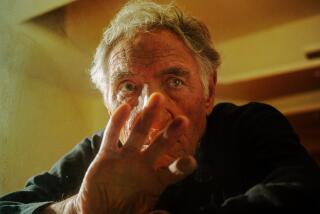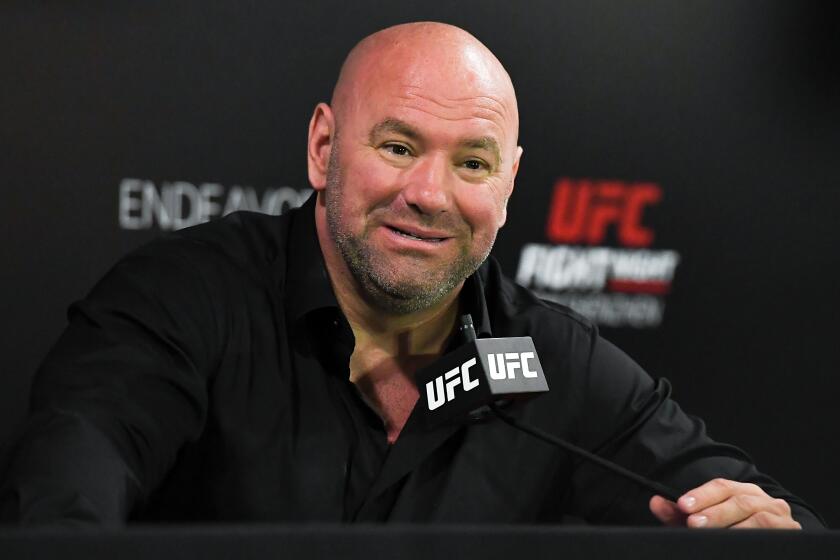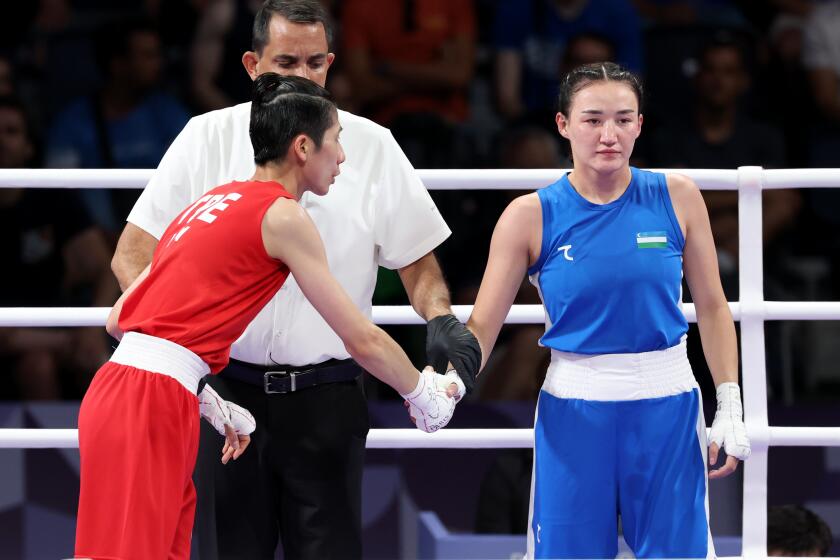Colorful L.A. boxer in the ‘40s and ‘50s
Art Aragon, the charismatic “Golden Boy” boxer who steadily drew standing-room-only crowds at Los Angeles and Hollywood venues in the 1940s and ‘50s, died Tuesday at Northridge Hospital Medical Center after his family removed him from life support. He was 80.
He suffered a stroke March 15, his son Brad said.
Aragon never won a world title, but he was inducted into the World Boxing Hall of Fame in 1990 with a 90-20-6 record that included several major bouts at the Olympic Auditorium, the old Wrigley Field and Hollywood’s Legion Stadium.
Longtime boxing publicist Bill Caplan said Aragon, who memorably entered the ring wearing a gold robe and gold trunks, will be remembered as “the top drawing card in L.A. boxing history.
“He was so colorful, and his fights were so exciting. He was a kill-or-be-killed kind of guy.”
His life outside the ring was also unforgettable. A native of Belen, N.M., who grew up in East Los Angeles, Aragon was married four times and engaged for a fifth wedding. He was also romantically linked to actress Mamie Van Doren, and had friendships with starlets Marilyn Monroe, Jayne Mansfield, Sophia Loren and Betty Martin, the ex-wife of Dean Martin, among several others, friends and associates said.
Van Doren, reached at her Newport Beach home, said she first met Aragon when she was 18 and held the title of Miss Palm Springs. She watched him fight at ringside, had dinner with him afterward and said she quickly fell in love.
“The ‘Golden Boy’ was a perfect title for him,” Van Doren said. “His smile turned everyone on. His skin was golden. His floppy hair bounced so perfectly. He was just so sexy.”
Aragon’s outstanding left hook made him a top-ranked lightweight. He started boxing in 1944 and his popularity grew in 1950 after he twice scored technical knockout victories over Angeleno favorite Enrique Bolanos of Mexico at the Olympic.
“The crowd loved Bolanos and booed Artie when it was over, but he thumbed his nose at them,” Caplan said. “It then became a tradition to boo Aragon.”
Reflecting on his career years ago in The Times, Aragon said he craved the treatment.
“Walking into the ring at the Olympic, 10,000 people there, wearing that gold robe, hearing all those boos, yeah I miss that,” he told writer Earl Gustkey. “You ever get booed by 10,000 people? It’s exciting. I liked it even better when I beat . . . some guy the crowd loved and then I’d look out at ‘em, give ‘em a big smile, and the boos would be even louder. I loved that.”
His problems making the lightweight limit of 135 pounds became legendary, too. He once joked that he was the only fighter that had to be carried into the ring.
In 1951, after he defeated Jimmy Carter in a non-title meeting earlier in the year, then-lightweight champion Carter knocked Aragon down in the sixth and 15th rounds to win a unanimous decision in a bout television broadcasters said was the first fight televised live from coast to coast.
Aragon’s career was also boosted by controversy. Tommy Campbell testified he “threw” a 1950 knockout loss to Aragon. Boxing officials claimed Carter sandbagged his first fight against Aragon on a Mafia figure’s orders, and the California Athletic Commission investigated judges who awarded Aragon a disputed decision over Chuck Davey in 1954.
Aragon was later convicted of offering opponent Dick Goldstein $500 to fix a 1956 fight, but the verdict was overturned on appeal. Aragon was coy to friends and family about what really happened, his son said.
In fact, when the attorney handling his appeal sent him a telegram telling him, “Justice was served,” Aragon answered, “Appeal again,” said former Times sportswriter John Hall.
From September 1954 to September 1958, Aragon was 21-1 with two victories over eventual world welterweight champion Don Jordan and a second triumph over Carter. He then fought former middleweight and welterweight champ Carmen Basilio at Wrigley Field and suffered a punishing eighth-round TKO loss.
During the fight, referee Tommy Hart reportedly warned Aragon he was close to stopping the bout, to which Aragon responded, “What are you waiting for?” He also kidded that he should have sold advertising on the soles of his shoes.
Aragon’s popularity gained him a role in the Audie Murphy film “To Hell and Back,” he counted Bob Hope as a golfing partner, and other friends included singer Sammy Davis Jr. and actors Robert Mitchum and William Holden.
Aragon announced his retirement from the ring after a 1960 TKO loss at the Olympic, and became a successful bail bondsman, with an office near the jail in downtown Los Angeles and, later, one in Van Nuys.
He remained a continual life of the party, once driving Times sports columnist Jim Murray to a strip club for lunch in 1963. Murray complained about the quality of the chicken he was eating, then described the reaction in the newspaper:
“ ‘Strippers cost three grand a week and you want squab under glass, too?’ Aragon screamed. He had me there.”
Aragon celebrated his 80th birthday at a Hollywood restaurant in November, entertaining friends and family (including three ex-wives) despite an ongoing struggle with pugilistic dementia, his son said.
“Dad was fulfilled,” Brad Aragon said. “He was married four times, had six kids, traveled the world, riding camels around the Egyptian pyramids. . . . I’m sitting here looking at 15 scrapbooks filled with memories.”
In addition to Brad, he is survived by four other children: Georgian, Audie, Mindy and Nancy; and four grandchildren. Another son, Art Jr., was killed in a motorcycle accident.
Services are pending.
--
More to Read
Go beyond the scoreboard
Get the latest on L.A.'s teams in the daily Sports Report newsletter.
You may occasionally receive promotional content from the Los Angeles Times.











